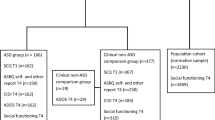Abstract
The modified Behavior Observation Scale adapted from Freeman et al. was used to compare normal, retarded, and autistic children with very low developmental ages and to determine the types of behavior that could differentiate these three diagnostic categories of children. Examination of the data revealed that there was much more overlap between autistic and retarded children than between autistic and normal children. However, a behavioral pattern of autism could be delineated and very retarded autistic children could be distinguished from the nonautistic retarded children. The autistic behavioral pattern included subclusters of symptoms that might be interpreted as disturbances of sensory modulation and motility.
Similar content being viewed by others
References
American Psychiatric Association. (1980).Diagnostic and statistical manual of mental disorders (3rd ed.). Washington, DC: Author.
Bartak, L., & Rutter, M. (1976). Differences between mentally retarded and normally intelligent autistic children.Journal of Autism and Childhood Schizophrenia, 6, 109–120.
Brunet, O., & Lezine, I. (1976). Psychomotor Development Scale in Infancy. InLe développement psychomoteur de la première enfance (4th ed.). Paris. P.U.F.
Freeman, B. J., Guthrie, D., Ritvo, E. R., Schroth, P., Glass, R., & Frankel, F. (1979). Behavior observation scale: Preliminary analysis of the similarities and differences between autistic and mentally retarded children.Psychological Reports, 44, 519–524.
Freeman, B. J., Ritvo, E. R., Guthrie, D., Schroth, P., & Ball, J. (1978). The behavior observation scale for autism.Journal of the American Academy of Child Psychiatry, 23, 588–594.
Freeman, B. J., Ritvo, E. R., Schroth, P., Tonick, I., Guthrie, D., & Wake, L. (1981). Behavioral characteristics of high and low-IQ autistic children.American Journal of Psychiatry, 3, 254–258.
Freeman, B. J., & Schroth, P. C. (1984). The development of the behavioral observation system (BOS) for autism.Behavioral Assessment, 6, 177–187.
Freeman, B. J., Schroth, P. C., Ritvo, E. R., Guthrie, D., & Wake, L. (1980). The behavior observation scale for autism (BOS): Initial results of factor analysis.Journal of Autism and Developmental Disorders, 10, 343–346.
Goldfarb, W. (1956). Receptor preferences in schizophrenic children.AMA Archives of Neurological Psychiatry, 76, 643–652.
Krug, D. A., Arick, J., & Almond, P. (1980). Behavior checklist for identifying severely handicapped individuals with high levels of autistic behavior.Journal of Child Psychology and Psychiatry, 21, 221–229.
Lelord, G., Muh, J. P., Barthelemy, C., Martineau, J., Garreau, B., & Callaway, E. (1981). Effects of Pyridoxine and Magnesium on autistic symptoms.Journal of Autism and Developmental Disorders, 11, 219–229.
Lelord, G., Martineau, J., Garreau, B., Barthelemy, C., Roux, S., & Bruneau, N. (1982). Event related potentials conditioning in children, psychopathological relevance in autistic syndromes. In A. Rothenberger (Ed.),Event-related potentials in children (Vol. 6, pp. 347–364). Amsterdam: Elsevier Biomedical Press.
Martineau, J., Garreau, B., Barthelemy, C., & Lelord, G. (1984). Evoked potentials and P300 during sensory conditioning in autistic children.Annals of the New York Academy of Sciences, 425, 362–369.
Ornitz, E. M. (1974). The modulation of sensory input and motor output in autistic children.Journal of Autism and Childhood Schizophrenia, 4, 197–315.
Ornitz, E. M., Guthrie, D., & Farley, A. (1977). The early development of autistic children.Journal of Autism and Childhood Schizophrenia, 7, 207–229.
Ornitz, E. M., Guthrie, D., & Farley, A. (1978). The early symptoms of childhood autism. In G. Serban (Ed.),Cognitive defects in the development of mental illness (pp. 24–42). New-York: Brunner/Mazel.
Ornitz, E. M. (1985). Neurophysiology of infantile autism.Journal of the American Academy of Child Psychiatry, 24, 251–262.
Parks, S. L. (1983). The assessment of autistic children: A selective review of available instruments.Journal of Autism and Developmental Disorders, 13, 255–267.
Rimland, B. (1968). On the objective diagnosis of infantile autism.Acta Paedopsychiatrica (Basel), 35, 146–161.
Rimland, B. (1971). The differentiation of childhood psychosis: an analysis of checklists for 2 218 psychotic children.Journal of Autism and Childhood Schizophrenia, 1, 161–174.
Ruttenberg, B. A., Dratman, M. L., Fraknoi, J., & Wenar, L. (1966). An instrument for evaluating autistic children.Journal of American Academy of Child Psychiatry, 5, 453–478.
Ruttenberg, B. A., Kalish, B. I., Wenar, C., & Wolf, E. G. (1977).Behavior rating instrument for autistic and other atypical children. Philadelphia: Developmental Center for Autistic Children.
Rutter, M. (1983). Cognitive deficits in the pathogenesis of autism.Journal of Child Psychology and Psychiatry, 4, 513–531.
Sauvage, D. (1984).Autisme du nourrisson et du jeune enfant (0–3 ans). Signes précoces et diagnostic. Paris: Masson.
Schopler, E., Reichler, R. J., De Vellis, R. F., & Daly, K. (1980). Toward objective classification of childhood autism: Childhood Autism Rating Scale (CARS).Journal of Autism and Developmental Disorders, 10, 79–97.
Wing, L., & Gould, J. (1978). Systematic recording of behaviors and skills of retarded and psychotic children.Journal of Autism and Childhood Schizophrenia, 8, 79–97.
Wing, L., & Gould, J. (1979). Severe impairments of social interaction and associated abnormalities in children: Epidemiology and classification.Journal of Autism and Developmental Disorders, 9, 11–29.
Author information
Authors and Affiliations
Additional information
This study was supported by C.N.R.S. (UA596), “Biology and Neuropsychiatry,” Sécurité Sociale 1982, and Fondation Langlois. We thank B. Baron, E. Vaudelon, J. Beurier-Charriere, P. Colombel, S. Roux, D. Lioret, and J. Sapede for their assistance.
Rights and permissions
About this article
Cite this article
Adrien, J.L., Ornitz, E., Barthelemy, C. et al. The presence or absence of certain behaviors associated with infantile autism in severely retarded autistic and nonautistic retarded children and very young normal children. J Autism Dev Disord 17, 407–416 (1987). https://doi.org/10.1007/BF01487069
Issue Date:
DOI: https://doi.org/10.1007/BF01487069




